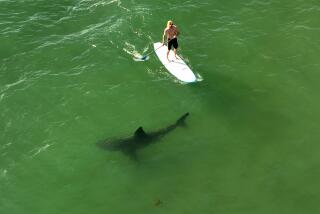Urchin Searchin’ : Divers Hope Limits on Harvest Will Preserve High-Profit Sea Creature
OXNARD — Brett Cunningham bounced across the sandy ocean bottom near Anacapa Island like a ballerina, plucking red sea urchins from the rocky underwater landscape with a pair of tongs.
As the diver, tethered to his boat by a thin, yellow air hose, quickly filled a four-foot-tall wire basket with the round, prickly spheres, he was mindful of a series of California Department of Fish and Game regulations that went into effect this month.
The new rules limit urchin fishermen across Southern California to only six days in the water during July, down from 14 last year. Fishing days also have been reduced in the prime-weather months of August and September, forcing divers to make the most of what little time they have.
It was the fear of seeing the slow depletion of all of California’s urchin beds--which bring in more than $80 million annually from the Japanese export market--that led the Department of Fish and Game to limit the number of fishing days and raise the minimum size for harvesting urchins. Sea urchin industry leaders helped formulate the tougher rules.
“The regulations are designed to compensate for the fact that we may still have too large a fishery in terms of divers,” Fish and Game biologist Dave Parker said.
Although the sea floor is still thick with sea urchins in many places along the California coast, Parker said, “there are a number of areas where sea urchins no longer are as abundant as they once were.”
The state’s urchin beds have yielded about 50 million pounds of urchins over each of the last several years. More than 90% of the catch is exported to Japan, where restaurateurs pay $35 to more than $200 per pound for urchin roe, a creamy, sweet delicacy used to make sushi.
Practically everyone involved in the industry--which has over the last five years ranked as one of California’s top fisheries in gross dollars and price per pound--agrees that the stricter regulations are necessary.
“Our industry benefits from having a consistent yield,” said Bruce Steele of the Santa Barbara-based California Urchin Divers Assn. “To achieve this, we decided that the industry must impose some regulations on itself.”
But many divers have expressed concern that the laws will cut their income and increase the safety risk in an already dangerous industry.
Deciding to work at a depth of 90 feet--a level that many urchin divers consider too deep--Cunningham had about 25 minutes to fill the two large nets he brought down on his first dive one day last week. By filling both bags and netting about 600 pounds of live urchins, he would be able to make shorter dives later in the day, when residual nitrogen in his body would increase the risks of deep diving.
“The bottom line is that the open and closed days make me work in weather I’d really rather not work in,” Cunningham, 26, said as he piloted his boat through six-foot waves.
“I don’t think they had safety in mind when they made this rule,” he said.
But for Cunningham, who has been an urchin diver for eight years, the benefits of deep diving at Anacapa outweigh the risks, especially considering the new rules.
It is more profitable, he said, than combing crowded spots near Santa Cruz Island or off the coast that have already been picked over by the 50 to 100 Ventura County divers with urchin licenses.
Bob Wallen, 55, of Ojai has also noted a safety concern. “I’ve already gone out on days during the regulated season that I would not have gone on before, so yes, it is causing a problem,” he said.
“But I think the rule changes were necessary,” said Wallen, who has been urchin diving for five years. “The stocks are being depleted too fast.”
This is the point emphasized by Steele, who has been an urchin diver for 19 years and is a member of the state’s Sea Urchin Advisory Committee, which drafted the new regulations.
“Which is worse?” he said in an interview. “To make money today and rob future generations of a product, or to take care of the resource--maybe picking a bit less now and ensuring the viability of the fishery over the long haul?”
In the early 1970s, when the fishery was open to practically anyone with a boat, an air compressor and a diving suit, it was not unheard-of for a single diver to bring in 15,000 pounds or more in a single day.
Back then, the price for whole urchins--set by Japanese buyers who run the processing plants and send the urchin roe to Japan by air freight--was often less than 10 cents a pound, Steele said.
Divers and other industry experts put the price for whole urchins today at 50 cents to more than $2 a pound, depending on size and quality. A good day’s take is anything over 1,000 pounds.
The roe--the industry’s euphemistic term for urchin gonads--make up less than 10% of the total weight, biologists say.
Still, Steele said “the average urchin diver is making considerably more than he did in 1985, when we began the legislative process imposing size limits and limiting seasons.”
One industry expert estimated that a diver working his own boat earns $50,000 to $70,000 a year before expenses.
The middlemen in the urchin industry are the large processing companies that clean, preserve and ship the packaged roe to Japan.
The new regulations have affected their business as well, forcing temporary layoffs and leading to concerns over the industry’s future here, said Jim Kawaguchi, plant manager for Tradewind Seafood Inc. in Oxnard.
More to Read
Sign up for Essential California
The most important California stories and recommendations in your inbox every morning.
You may occasionally receive promotional content from the Los Angeles Times.








